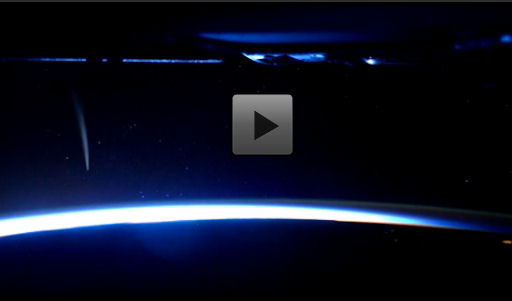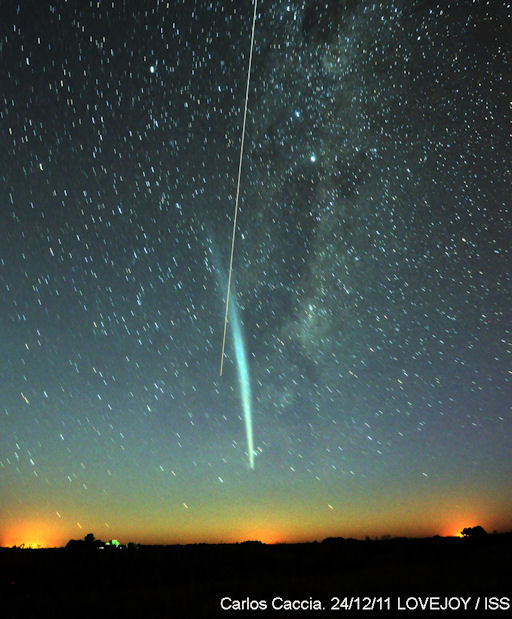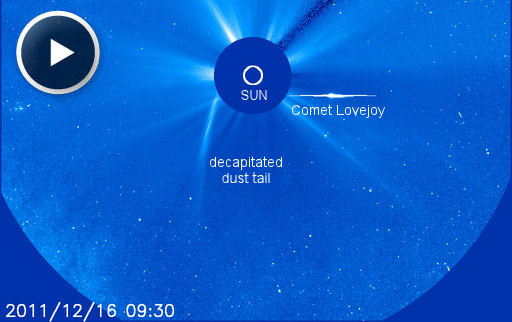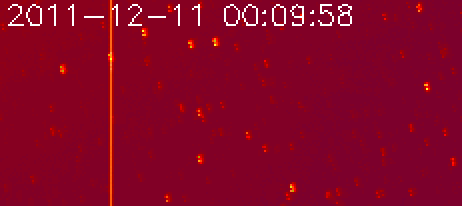Komet Lovejoy aus dem Erd-Orbit betrachtet - 24. Dezember 2011
COMET LOVEJOY FROM ORBIT: Veteran astronaut Dan Burbank has seen many amazing things. Once, he even flew through the aurora borealis. So when Burbank says "[Comet Lovejoy] is the most amazing thing I have ever seen in space," it really means something. Currently serving onboard the International Space Station, Burbank photographed the sungrazing comet on Dec. 21st, an experience he describes in this NASA video:
Burbank describes the tail of Comet Lovejoy as a "green glowing arc at least 10 degrees long." He saw it just before orbital sunrise emerging from Earth's limb, which was "lit up as a bright sliver of blue and purple."
After plunging through the sun's atmosphere only 120,000 km above the stellar surface on Dec. 16th, and improbably surviving, Comet Lovejoy has become the finest comet since Comet McNaught in 2007. Its orbit is carrying it through the skies of the southern hemisphere where sunrise sky watchers are seeing the comet almost as clearly as Burbank did. One wonders if Burbank was looking out the window on Dec. 24th when Carlos Caccia took this picture of the ISS transiting Lovejoy's tail over Intendente Alvear, Argentina:
"The ISS passed through the Southern Cross, continued parallel to the Milky Way, and finally arrived at the tail of Lovejoy with its typical golden color," says Caccia. "What a lucky shot!"
The visibility of Comet Lovejoy should continue to improve in he mornings ahead as the comet moves away from the sun into the darker skies before dawn. Sky watchers should set their alarm for an early-Christmas treat.
Viele unbekannte Objekte auf NASA-SOHO Satelliten aufgezeichnet - 22. Dezember 2011
Komet Lovejoy überlebt - 16. Dezember 2011
COMET LOVEJOY SURVIVES: Incredibly, sungrazing Comet Lovejoy appears to have survived its close encounter with the sun. Lovejoy flew only 140,000 km over the stellar surface during the early hours of Dec. 16th. NASA's Solar Dynamics Observatory caught the comet emerging from perihelion (closest approach). Click on the image to play an amazing movie:
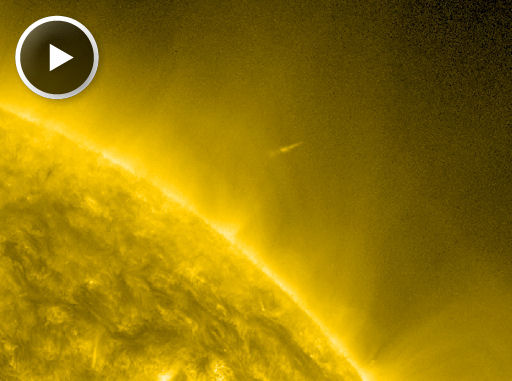
Movie formats: 25 MB Quicktime, 800 kB m4v
Comet Lovejoy began the week as a chunk of dusty, rocky ice some 200 meters in diameter. No one can say how much of the comet's core remains intact or how long it will hang together after the searing heat of perihelion. Another movie from SDO hints at the rough treatment this comet has endured.
New images from the Solar and Heliospheric Observatory confirm that Comet Lovejoy survived perihelion and is now receding from the sun:
Curiously, the comet seems to have lost its tail in transit through the sun's atmosphere. A decapitated remnant tail can still be seen tracing Comet Lovejoy's path into the sun, but the exiting comet has no obvious trail of dust behind it. Stay tuned for more discussion of this point.
Bilder vom Kometen Lovejoy - 15. Dezember 2011
BIG COMET PLUNGES TOWARD THE SUN: Comet Lovejoy (C/2011 W3) is diving into the sun and furiously vaporizing as it approaches the stellar surface. The Solar and Heliospheric Observatory (SOHO) is recording the kamikaze plunge:
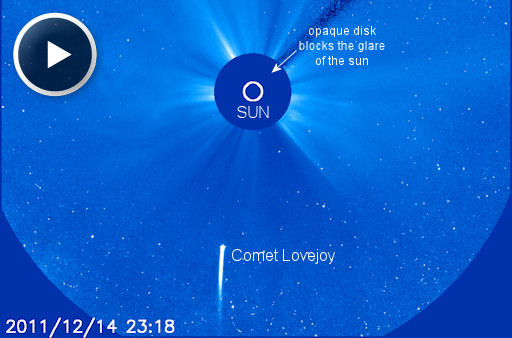
SOHO Coronagraph: movie, latest image
"This is, without any doubt, the brightest sungrazing comet that SOHO has ever seen," says comet researcher Karl Battams of the Naval Research Lab in Washington DC.
The comet's nucleus, thought to be twice as wide as a football field, will skim approximately 140,000 km (1.2 solar radii) above the solar surface on Dec. 15/16. At such close range, solar heating will almost certainly destroy the comet's icy core, creating a cloud of vapor and comet dust that will reflect lots of sunlight.
"If Comet Lovejoy gets as bright as magnitude -4 or -5, there is a tiny but non-zero chance that it could become visible in the sky next to the sun," says Battams.
Indeed, something similar happened to Comet McNaught in January 2007 when it was visible in broad daylight: gallery. Standing in the shadow of a tall building to block the sun allowed the comet to be seen in blue sky nearby.
"Comet Lovejoy will be reaching perihelion (closest approach to the sun) right around sunset on Dec. 15th for people in the US East, Central, Mountain, and Pacific time zones," continues Battams. "Be alert for the comet to the left of the sun at that time." Caution: Do not look at or near the sun through unfiltered optics; focused sunlight can seriously damage your eyes.
Discovered on Dec. 2nd by amateur astronomer Terry Lovejoy of Australia, the comet is an unusually large member of the Kreutz family. Kreutz sungrazers are fragments of a single giant comet (probably the Great Comet of 1106) that broke apart back in the 12th century. SOHO sees one plunging into the sun every few days, but most are small, no more than 10 meters wide. Comet Lovejoy is at least ten times larger than usual.
Source: http://spaceweather.com/
Komet Lovejoy auf seinem Weg zur Sonne - 14. Dezember 2011


Der Komet "Lovejoy" wird voraus-sichtlich am 15.-16. Dezember seine grösste Helligkeit erreichen und vielleicht sogar während des Tages sichtbar sein, so die Astronomen.

Der NASA SOHO Satellit LASCO C3 zeichnet den Kometen C/2011 W3, auch genannt Komet "Lovejoy" auf seinem Weg zur Sonne auf.
SIGNIFICANT COMET PLUNGES TOWARD THE SUN: A comet nearly as wide as two football fields (200m) is plunging toward the sun where it will most likely be destroyed in a spectacular light show on Dec. 15/16. Although Comet Lovejoy (C/2011 W3) could become as bright as Jupiter or Venus when it "flames out," the glare of the sun will hide the event from human eyes. Solar observatories in space, however, will have a grand view. NASA's STEREO-B spacecraft recorded the comet's approach on Dec. 11:
"You can clearly see the comet heading diagonally through the images," says Karl Battams of the Naval Research Lab who prepared the animation. "During the 16-hour sequence, the comet brightens from magnitude +8 to +6.5, approximately."
It will soon grow much brighter. "This comet is a true sungrazer, and will skim approximately 140,000 km (1.2 solar radii) above the solar surface on Dec. 15/16," notes Battams. At such close range, solar heating will almost certainly destroy the icy interloper,creating a cloud of vapor and comet dust that will reflect lots of sunlight. The Solar and Heliospheric Observatory (SOHO) will have a particularly good view.
 Disclosure - Enthüllung des UFO Phänomens/Freie Energie
Erstkontakt - Begegnung mit unseren Sternengeschwistern
Disclosure - Enthüllung des UFO Phänomens/Freie Energie
Erstkontakt - Begegnung mit unseren Sternengeschwistern




